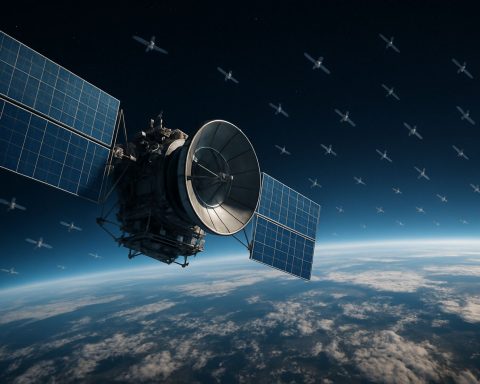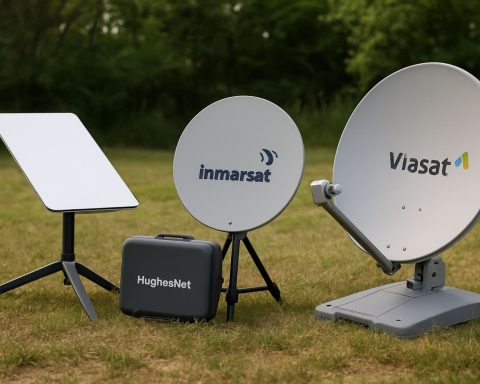Unveiling the Satellite Internet Revolution: How 10,000 Satellites Are Powering Connectivity for Millions
- Satellite Internet Market: Current Landscape and Key Drivers
- Emerging Technologies Shaping Satellite Connectivity
- Key Players and Shifting Dynamics in Satellite Internet
- Projected Expansion and User Adoption Trends
- Global Hotspots: Regional Growth and Adoption Patterns
- What’s Next for Satellite Internet: Innovations and Impact
- Barriers to Growth and New Avenues for Expansion
- Sources & References
“The State of Artificial Intelligence: July 2025 Artificial Intelligence (AI) continues to transform every facet of society, from business and education to healthcare, entertainment, and geopolitics.” (source)
Satellite Internet Market: Current Landscape and Key Drivers
The satellite internet market is undergoing a dramatic transformation, with projections indicating that by 2025, over 10,000 active satellites will be delivering broadband connectivity to more than 5 million users worldwide. This surge is driven by the rapid deployment of low Earth orbit (LEO) satellite constellations, spearheaded by companies such as SpaceX’s Starlink, OneWeb, and Amazon’s Project Kuiper.
As of early 2024, Starlink alone has launched over 5,500 satellites, with plans to reach 12,000 by the end of 2027 (SpaceX Updates). OneWeb has deployed more than 600 satellites, aiming for global coverage, while Amazon’s Project Kuiper is preparing to launch its first batch of satellites in 2024 (CNBC). Collectively, these initiatives are expected to push the total number of operational internet satellites past the 10,000 mark by 2025.
The user base is expanding rapidly. Starlink reported over 2.3 million subscribers globally as of May 2024 (PCMag), with OneWeb and other providers targeting millions more as they scale up services. Industry analysts forecast that the total number of satellite internet users will surpass 5 million by 2025, fueled by demand in rural, remote, and underserved regions (Statista).
- Key Drivers:
- Global Connectivity: Satellite internet bridges the digital divide, offering high-speed access where terrestrial infrastructure is lacking.
- Technological Advancements: Innovations in satellite miniaturization, reusable rockets, and phased array antennas have slashed launch costs and improved service quality.
- Rising Data Demand: The proliferation of IoT devices, cloud services, and remote work is driving up global bandwidth requirements.
- Government Initiatives: Public sector programs and subsidies are accelerating satellite broadband adoption in underserved areas (FCC Broadband Funding Map).
As the satellite internet revolution accelerates, the market is poised for exponential growth, reshaping global connectivity and digital inclusion by 2025 and beyond.
Emerging Technologies Shaping Satellite Connectivity
The satellite internet landscape is undergoing a dramatic transformation, with projections indicating that by 2025, over 10,000 active satellites will orbit the Earth, serving an estimated 5 million users worldwide. This surge is driven by rapid advancements in satellite technology, miniaturization, and the deployment of large-scale low Earth orbit (LEO) constellations by both private and public sector players.
- LEO Mega-Constellations: Companies like SpaceX (Starlink), OneWeb, and Amazon (Project Kuiper) are leading the charge, collectively planning to launch tens of thousands of satellites. As of early 2024, Starlink alone has deployed over 5,000 satellites, with plans to reach 12,000 by 2027 (Statista).
- Expanding User Base: The number of satellite internet users is expected to surpass 5 million by 2025, up from approximately 2.3 million in 2023 (Analysys Mason). This growth is fueled by demand in rural and underserved regions, where terrestrial broadband remains limited or unavailable.
- Technological Innovations: Advances in phased array antennas, inter-satellite laser links, and AI-driven network management are enhancing bandwidth, reducing latency, and improving reliability. For example, Starlink’s latest satellites feature optical interlinks, enabling direct data transfer between satellites and reducing dependence on ground stations (Teslarati).
- Global Impact: The proliferation of satellite internet is expected to bridge the digital divide, support disaster recovery, and enable connectivity for IoT devices, autonomous vehicles, and remote industries. The global satellite internet market is projected to reach $18.59 billion by 2030, growing at a CAGR of 14.6% (GlobeNewswire).
As we approach 2025, the satellite internet revolution is poised to reshape global connectivity, making high-speed internet accessible to millions more and catalyzing new economic and social opportunities worldwide.
Key Players and Shifting Dynamics in Satellite Internet
The satellite internet sector is undergoing a dramatic transformation, with projections indicating that by 2025, over 10,000 active satellites will be orbiting Earth, serving an estimated 5 million users worldwide. This surge is driven by ambitious private sector initiatives, government partnerships, and technological advancements that are reshaping global connectivity.
- Starlink (SpaceX): As the undisputed leader, SpaceX’s Starlink constellation has already launched more than 5,500 satellites as of early 2024, with plans to reach 12,000 by 2027. Starlink’s subscriber base surpassed 2.6 million users globally in 2024, and the company is rapidly expanding coverage in underserved regions (CNBC).
- OneWeb: Backed by the UK government and Bharti Global, OneWeb has deployed over 600 satellites, focusing on enterprise and government clients. The company aims to provide global coverage by 2025, targeting remote and rural areas (BBC).
- Amazon Project Kuiper: Amazon’s entry into the market is set to intensify competition. With regulatory approval for 3,236 satellites, Project Kuiper plans to begin service in late 2025, leveraging Amazon’s logistics and cloud infrastructure (Reuters).
- China’s Guowang: China is accelerating its own low Earth orbit (LEO) constellation, Guowang, with plans for 13,000 satellites. The project is part of China’s broader digital infrastructure strategy, aiming to rival Western constellations (SpaceNews).
The rapid deployment of LEO satellites is lowering latency and increasing bandwidth, making satellite internet a viable alternative to terrestrial broadband. This is particularly transformative for remote, rural, and developing regions, where traditional infrastructure is lacking. The competitive landscape is also shifting, with new entrants and national projects challenging established players, driving innovation and price reductions.
By 2025, the satellite internet revolution is expected to connect millions more, bridging the digital divide and enabling new economic opportunities worldwide (ITU).
Projected Expansion and User Adoption Trends
The satellite internet sector is on the cusp of a transformative expansion, with projections indicating that by 2025, over 10,000 active satellites will be orbiting the Earth to deliver broadband connectivity. This surge is primarily driven by mega-constellation projects such as SpaceX’s Starlink, Amazon’s Project Kuiper, and OneWeb, all of which are rapidly deploying low Earth orbit (LEO) satellites to meet escalating global demand for high-speed internet access (Statista).
As of early 2024, there are approximately 7,500 active satellites in orbit, with Starlink alone accounting for over 5,000. The pace of launches is accelerating, with SpaceX planning to deploy up to 42,000 satellites in the coming years, and Amazon aiming for 3,236 satellites for its Kuiper constellation (CNBC). By 2025, industry analysts forecast that the 10,000-satellite milestone will be surpassed, dramatically increasing global coverage and bandwidth capacity (SpaceNews).
User adoption is expected to mirror this infrastructure boom. In 2023, Starlink reported over 2 million subscribers worldwide, a figure that is projected to more than double by 2025 as service expands into new markets and regulatory barriers are addressed (Reuters). Combined with anticipated uptake from OneWeb, Kuiper, and regional providers, the global satellite internet user base is forecast to reach at least 5 million by 2025 (Analysys Mason).
- Rural and Remote Access: The primary driver of adoption is the ability to deliver reliable broadband to underserved and remote regions, where terrestrial infrastructure is lacking or cost-prohibitive.
- Enterprise and Mobility: Businesses, maritime, and aviation sectors are increasingly adopting satellite internet for resilient, global connectivity.
- Affordability and Speed: As competition intensifies and technology matures, user equipment costs are falling and speeds are rising, making satellite internet a viable alternative to traditional broadband.
In summary, the satellite internet revolution of 2025 is set to be defined by a tenfold increase in orbital infrastructure and a rapidly expanding user base, fundamentally reshaping global digital connectivity.
Global Hotspots: Regional Growth and Adoption Patterns
The satellite internet sector is undergoing a dramatic transformation, with 2025 poised to be a landmark year. The number of active satellites in orbit is expected to surpass 10,000, driven by mega-constellations from companies like SpaceX’s Starlink, Amazon’s Project Kuiper, and OneWeb. This surge is not just a technological feat—it’s reshaping global connectivity, with user adoption projected to exceed 5 million worldwide by the end of 2025 (Analysys Mason).
Regional Growth Hotspots
- North America: The United States and Canada remain at the forefront, accounting for over 40% of global satellite internet users. Rural and underserved communities are the primary beneficiaries, with Starlink reporting over 2 million subscribers in North America alone as of early 2024 (CNBC).
- Asia-Pacific: Rapid adoption is underway in countries like India, Indonesia, and the Philippines, where terrestrial infrastructure lags. The region is expected to see user numbers double by 2025, with government-backed initiatives accelerating deployment (GSMA).
- Sub-Saharan Africa: Satellite internet is bridging the digital divide, with new partnerships and regulatory support. User growth rates are among the highest globally, albeit from a smaller base, as providers target remote schools, clinics, and businesses (Brookings).
- Europe: Adoption is steady, particularly in rural Scandinavia, Eastern Europe, and the Mediterranean. The European Union’s focus on digital inclusion is spurring investment and cross-border collaborations (European Commission).
Key Drivers and Challenges
- Affordability: Falling hardware and subscription costs are making satellite internet accessible to millions more.
- Latency and Speed: Next-generation low Earth orbit (LEO) satellites are delivering speeds of 100 Mbps or more, rivaling terrestrial broadband (Speedtest).
- Regulatory Hurdles: Spectrum allocation and licensing remain complex, especially in emerging markets.
As the satellite internet revolution accelerates, 2025 will mark a tipping point—reshaping digital access and economic opportunity across continents.
What’s Next for Satellite Internet: Innovations and Impact
The satellite internet industry is on the cusp of a transformative leap, with projections indicating that by 2025, more than 10,000 active satellites will orbit the Earth, serving over 5 million users worldwide. This rapid expansion is driven by ambitious projects from companies like SpaceX, Amazon, and OneWeb, all racing to deploy vast low-Earth orbit (LEO) constellations that promise to deliver high-speed, low-latency internet to even the most remote corners of the globe.
- Explosive Growth in Satellite Numbers: As of early 2024, there are approximately 7,500 active satellites in orbit, with SpaceX’s Starlink alone accounting for over 5,000 of them (Union of Concerned Scientists). By 2025, industry analysts expect this number to surpass 10,000, fueled by ongoing launches and the entry of new players like Amazon’s Project Kuiper, which aims to deploy over 3,200 satellites in the coming years (CNBC).
- User Base Expansion: The number of satellite internet users is set to exceed 5 million globally by 2025, up from an estimated 2.3 million in 2023 (Statista). Starlink leads the market, but new entrants and expanded coverage are expected to drive adoption in underserved regions across Africa, Asia, and Latin America.
- Technological Innovations: Next-generation satellites are being equipped with advanced phased-array antennas, laser inter-satellite links, and AI-powered network management, enabling faster speeds and more reliable connections (Space.com). These innovations are crucial for supporting bandwidth-intensive applications like telemedicine, remote education, and disaster response.
- Market Impact: The satellite internet revolution is expected to generate over $30 billion in annual revenue by 2025, with significant implications for telecom competition, digital inclusion, and global connectivity (Morgan Stanley).
As the satellite internet ecosystem matures, the convergence of massive satellite constellations, cutting-edge technology, and expanding user bases is set to redefine how the world connects, bridging the digital divide and unlocking new economic opportunities on a global scale.
Barriers to Growth and New Avenues for Expansion
The satellite internet industry is on the cusp of a transformative leap, with projections indicating that by 2025, over 10,000 active satellites could be orbiting Earth to serve an estimated 5 million users worldwide. This revolution, driven by constellations from companies like SpaceX’s Starlink, Amazon’s Project Kuiper, and OneWeb, promises to bridge the digital divide, especially in remote and underserved regions. However, the path to this ambitious milestone is fraught with significant barriers, even as new avenues for expansion emerge.
- Regulatory and Spectrum Challenges: The rapid deployment of thousands of satellites has intensified competition for orbital slots and radio frequency spectrum. Regulatory bodies such as the International Telecommunication Union (ITU) and national agencies are under pressure to manage interference and ensure equitable access. Delays in licensing and cross-border coordination remain persistent hurdles.
- High Capital Expenditure: Building, launching, and maintaining large satellite constellations require billions in upfront investment. For example, SpaceX has invested over $10 billion in Starlink to date. This financial barrier limits market entry to only the most well-funded players, potentially stifling innovation and competition.
- Technical and Logistical Complexities: Managing a network of 10,000+ satellites involves sophisticated ground infrastructure, advanced tracking, and collision avoidance systems. The risk of space debris and the need for sustainable end-of-life satellite disposal are growing concerns, as highlighted by the European Space Agency.
- Affordability and Accessibility: While satellite internet can reach remote areas, the cost of user terminals and monthly subscriptions remains high for many potential customers. Efforts to reduce hardware costs and offer subsidized pricing are underway, but widespread affordability is still a barrier to mass adoption (Bloomberg).
Despite these challenges, new avenues for expansion are emerging. Advances in satellite miniaturization and reusable launch vehicles are driving down costs. Partnerships with governments and telecom operators are opening new markets, particularly in Africa, Asia, and Latin America. Additionally, the integration of satellite internet with 5G and IoT ecosystems is creating opportunities for enterprise and industrial applications (GSMA). As the industry overcomes its barriers, the vision of connecting 5 million users via 10,000 satellites in 2025 is rapidly becoming a reality.
Sources & References
- 10,000 Satellites and 5 Million Users: Inside the Satellite Internet Revolution of 2025
- SpaceX (Starlink)
- Amazon (Project Kuiper)
- SpaceX has invested over $10 billion
- Statista
- Analysys Mason
- Teslarati
- GlobeNewswire
- BBC
- SpaceNews
- International Telecommunication Union (ITU)
- Brookings
- European Commission
- Speedtest
- Union of Concerned Scientists
- Space.com
- Morgan Stanley
- European Space Agency








